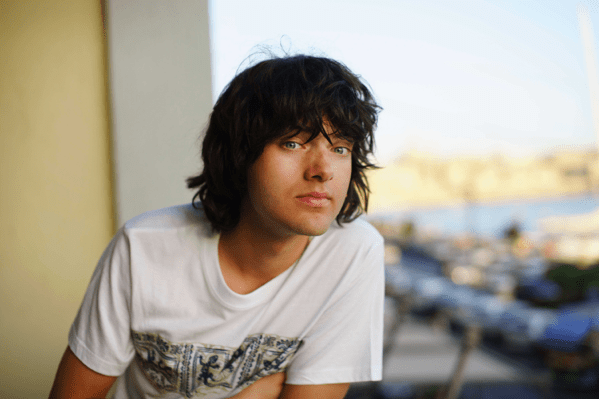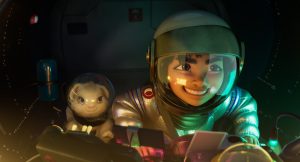“For society to progress, we should not only move forward but also cleanup after ourselves.”1

By NOAA | Courtesy of Wikimedia Commons
Over the last forty years, our oceans have been filling with tons of plastic debris. The plastic is carried by the ocean currents and it all converges in five major accumulation zones, commonly called “Garbage Patches.”2 Many scientists predict that if this problem is not solved, there will be major consequences. Garbage will block the sunlight in the oceans, resulting in many species of sea plants and animals dying. Moreover, the environment will be affected in such ways that the entire food chain of the world will suffer major changes. Dutch inventor Boyan Slat has come up with an idea to solve this problem.3
Boyan Slat is a 24-year-old Dutch inventor, who has been interested in engineering projects since he was very young. At the age of fourteen, he even set a Guinness World Record by launching 213 water rockets at the same time.4 When he was sixteen, he went diving in the waters of Greece and was so surprised to see more plastic underwater than fish. That was the moment when Slat began the idea of cleaning up the ocean. Over the last forty years, millions of tons of plastic have entered the oceans creating huge garbage patches. The largest such patch is located between Hawaii and California. After his trip to Greece, Boyan became obsessed with this problem. During high-school, all of his science projects were about understanding this problem and trying to solve the “million-dollar” question “why this cleanup is considered impossible?”5

After high-school, Boyan was invited to TEDtx to tell the world his idea. At first, his ideas didn’t seem to be really interesting to the public, so he went on with his life. He started working as an aerospace engineer in TU Delft, but he just couldn’t let go of his idea. But the simple thought of not being able to come up with a solution to this major problem was killing him. He was thinking about the terrible consequences, in several years, for the planet if no one did anything.6
After several months he came into the spotlight again because some news sites had picked up his TED speech and became interested in his story. Slat even dropped out of college to pursue his dream.7
He had always enjoyed solving problems and puzzles. But this time was going to be different. This time the puzzle was to get rid of the plastic in the oceans. He just had to find the perfect pieces to accomplish that. At the young age of eighteen, he founded a non-profit organization called The Ocean Cleanup, in order to develop new technology to tackle this almost impossible task.8
And this is when the real adventure began for Slat. Instead of picking up all the plastic bottles with nets, which according to experts it would cost millions of dollars and take thousands of years, his idea was to use the power of natural currents to gather plastic into long floating rubber barriers. But developing this great plan wasn’t an easy task. It required money, time, and many experts in different fields. In an interview, Slat said “When I started, I thought I would likely fail, and I still might, but considering the scale of the problem, it was important to at least try.”9
His ideas started coming together when several experts, such as engineers, oceanographers, recycling companies, and scientists volunteered to complete a study, which ended up indicating that the The Ocean Cleanup project had a feasible and viable method for removing large amounts of plastic. But this was only the first step. Slat still needed a lot of money to start the project. So his next step was to take his story and project to the rest of the world. He has since gained the support of 160 countries, 38,000 funders, and collected over 2 million USD. With this money, he was closer to accomplishing his dream, but, again, this was just another piece of a big puzzle.10

Later, The Ocean Cleanup started developing prototypes, then getting into trials, failing and learning from mistakes, and finally the got it right. They mapped an area of 3.5 million squared kilometers of plastic and marine debris, known as the “great pacific garbage patch.” After that, Slat gave an interview arguing that most people had an image of this patch as an island where you can practically walk on, but that couldn’t be more wrong. It stretches for millions of kilometers and it would take thousands of years to clean it up.11 So he targeted that area to clean first. The first Ocean Cleanup system was launched on September 8, 2018. He is hoping to clean up to 50% within five years.12
This amazing story is only getting started, so if you want to follow the progress of this project, you can follow their official organization page (www.theoceancleanup.com).
- The Ocean Cleanup, “The largest Cleanup history,” The Ocean Cleanup, June 6, 2017. Accessed September 8. www.theoceancleanup.com. ↵
- NOAA, “Great Pacific Garbage Patch,” National Geographic, June 5, 2015. Accessed September 8. https://www.nationalgeographic.org/encyclopedia/great-pacific-garbage-patch/. ↵
- U.S. Government Publishing Office, “Endangered status for North Pacific and North Atlantic Right Whales,” (Federal register: Vol. 73, No. 45. Thursday, 2008), 12024-12030. ↵
- Viveke Venema, “The Dutch boy mopping up a sea of plastic,” BBC News, October 17, 2017. Accessed September 7. https://www.bbc.com/news/magazine-29631332. ↵
- Susan Caminiti, “Thiel backing 22-year-old’s dream to clean up world’s oceans,” CNBC.com, April 22, 2017. Accessed September 5. https://www.cnbc.com/2017/04/20/thiel-benioff-backing-22-year-olds-dream-to-clean-up-worlds-oceans.html. ↵
- The Ocean Cleanup, “How it all began,” The Ocean Cleanup, June 6, 2017. Accessed September 8. www.theoceancleanup.com. ↵
- The Ocean Cleanup, “How it all began,” The Ocean Cleanup, June 6, 2017. Accessed September 8. www.theoceancleanup.com. ↵
- Susan Caminiti, “Thiel backing 22-year-old’s dream to clean up world’s oceans,” CNBC.com, April 22, 2017. Accessed September 5. https://www.cnbc.com/2017/04/20/thiel-benioff-backing-22-year-olds-dream-to-clean-up-worlds-oceans.html. ↵
- Viveke Venema, “The Dutch boy mopping up a sea of plastic,” BBC News, October 17, 2017. Accessed September 7. https://www.bbc.com/news/magazine-29631332. ↵
- The Ocean Cleanup, “Milestones,” The Ocean Cleanup, June 6, 2017. Accused September 8. www.theoceancleanup.com. ↵
- Marian Liu, “Great Pacific Garbage Patch Now Three Times the Size of France,” CNN, 23 Mar. 2018. Accessed September 6 2018. www.cnn.com/2018/03/23/world/plastic-great-pacific-garbage-patch-intl/index.html. ↵
- The Ocean Cleanup, “Milestones,” The Ocean Cleanup, June 6, 2017. Accessed September 8. www.theoceancleanup.com. ↵



78 comments
Amariz Puerta
I really enjoyed reading this article it was very informative and went together very nicely. I like how it started with a quote, and it really helped set the tone for the essay. I like how Slat addressed how this problem is affecting us. I have known about this issue but never knew the extreme of it. Very well written essay and very informative.
Rebeca Escobar
Our oceans are so important, and even more so the marine life in it. We need to do what we can to clean up the oceans; we put so many species at risk by not doing anything. So many people ignore this issue, and it’s obvious they do because they continue to litter and refuse to clean up after themselves! It’s not that hard, just take a plastic bag with you and throw your trash in it. I applaud Slat for presenting a solution for this issue, even if it seems too big to handle.
Chelsea Alvarez
This article is very well written and informative. The garbage that gets built up in the oceans due to lack of regard for all of the animal species that inhabit the waters is selfish. I like how Slat was interested in the cause and decided to take action against it. I like how Slat further researched what would had to be done to find a solution to the problem by integrating floating barriers where the plastic would collect. I hope that this problem attracts more individuals and grows awareness so it does not worsen.
Maya Mani
It’s such a relief to read his plan is taking action. A lot of times, it seems like we address the issues about the environment but do little to fix them. It seems like such an impossible task, yet Boyan stepped up and developed an incredible plan. Super impressive and I’m excited to see their progress in the next few years.
Ruby Wynn
This is an excellent article. It is devastating that we have so much trash in our oceans. I am impressed that Boyan Slat was so inspired to clean up the oceans at 16 years old, and that he dropped out of college be able to focus on his project of cleaning up the oceans. It is inspiring to read that he is having success with his project, and that part of the ocean is starting to be restored.
Matthew Swaykus
I have to commend the way in which this article was pieced together. The paragraphs flowed together and Slat was neatly tried into the story. It was very informative about what the problem is, how Slat plans on solving it, and how the project is coming so far. Along with that, the quote was a masterstroke. By quoting the The Ocean Cleanup non-profit organization, the reader is enticed with the ethical argument that this foundation is in the right.
Katherine Wolf
We need more people like Boyan Slat, people that see a problem and even if the odds seem against them, they just go for it. I have always heard about the garbage in the ocean but never realized the extent of it. Just the extend is alarming, not to mention the impact it will have on the marine life. I wonder what they will do with the garbage they collect, I’m assuming most of it will be plastic so they will probably recycle it.
Natalie Thamm
I really liked the quote that the article started with, it definitely gave something to keep in mind while reading the article and I really liked the inclusion at the bottom for more information on the project. I knew some of the so called garbage patches, but had not realized the extent to which they have taken over the oceans. Slat really shows the difference that one person with an idea can make.
Matthew Wyatt
This article is important, not only for reminding the reader of the current ecological devastation of the world’s oceans but also for informing the reader about a promising effort to clean it up. The article could, however, benefit from one more round of editing for typos and grammatical errors. For example, in the first sentence of the second-to-last paragraph “the” should be changed to “they.” This and other similar edits will only add to the strength of an already well-written article.
Katherine Watson
You do not understand how ecstatic this article makes me feel. This man is on a mission to turn back the harmful effects we have left on poor mother nature, and he will not stop until he is complete. I wish more people were more considerate about the impact that one individual can make by just picking up a piece of trash off the sidewalk.
We always preach about how we want Earth to be around for generations to see, and especially for them to see the great wonders and creatures that live here. But, then we go and have spring breakers who go out and spend a whole week littering and adding on to the amount of damage that has already been done.
Please, when you are thinking about your future, think about the home you have, and the home you share with all of Earth’s creatures. Think about how we all have one home, and we have one chance to make sure it lives as long as we do.